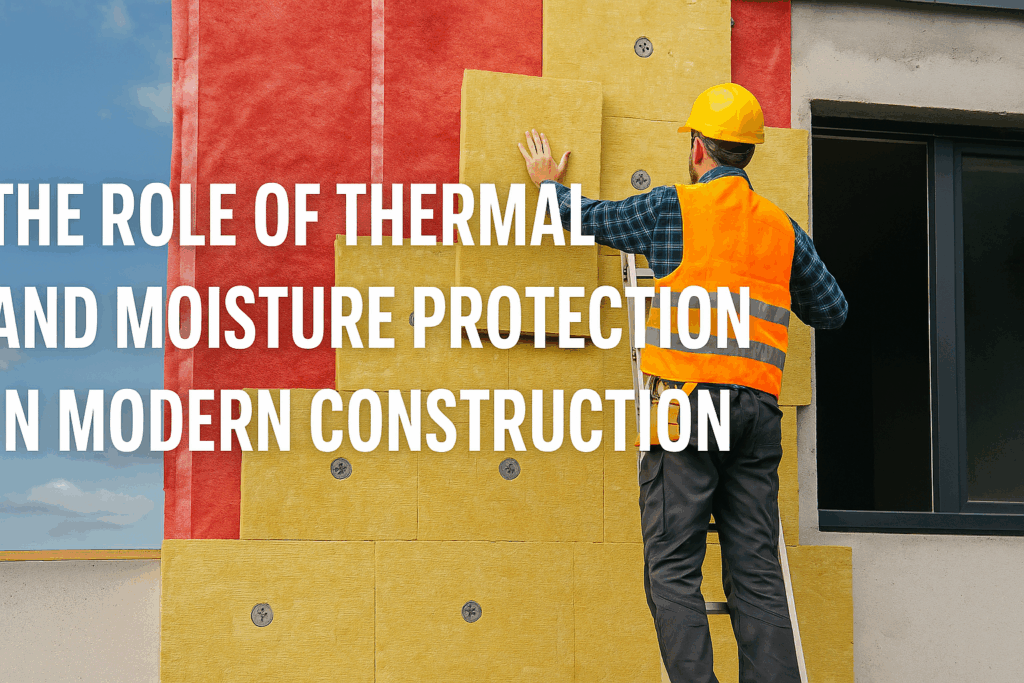The Role of Thermal and Moisture Protection in Modern Construction
In today’s growing construction industry, thermal and moisture protection are important elements of any building. These systems help to maintain the building’s comfort, energy efficiency, and durability. In this area, people are looking for more energy-saving solutions, and the need for these protections has increased. Thermal and moisture protection controls indoor temperatures and blocks moisture.
It improves comfort and enhances the building’s durability. These protections also protect buildings from water damage, mold growth, and long-term damage to the structure. This article explains the importance of thermal and moisture protection. It shows how they improve energy efficiency and benefit the environment.
What is Thermal and Moisture Protection?
Thermal protection means using materials and methods to maintain the indoor temperature. It helps reduce heat transfer inside or outside the building. Moisture protection is also important because it stops the water and moisture from entering the building. This is necessary because water can damage the structure, and cause mold growth, which leads to costly repairs.
Thermal Protection
Thermal protection helps maintain a building’s temperature. It also enhances energy efficiency, reducing energy costs. Thermal protection uses materials like fiberglass and spray foam. These materials reduce heat transfer and keep the building comfortable year-round.
Moisture Protection
Moisture protection controls water and air moisture from entering the building. If it is not reliable, it can lead to issues such as water damage, mold, mildew, and rust. Moisture affects the structure of a building and compromises the health of its residents. Moisture barriers, like vapor retarders and waterproof membranes, are essential. They protect foundations, roofs, and walls from water infiltration.
The Role of Thermal and Moisture Protection in Construction
Thermal and moisture protection in construction are essential components of modern buildings. These protections improve energy efficiency and comfort. They also extend the building’s lifespan. Here’s how they help:
Improve Energy Efficiency
The clearest benefit of thermal and moisture protection is improved energy efficiency. By using the insulation, you can protect the building from water leakage and reduce the need for cooling or heating systems. Thermal and moisture protection reduces energy waste. It makes the building more sustainable and cost-effective.
Better Comfort and Health
Thermal and moisture protection improve comfort, particularly in indoor environments. Proper insulation is key to maintaining a comfortable temperature for residents. Effective moisture protection keeps buildings dry. It prevents mold and mildew growth, ensuring better indoor air quality. Thermal and moisture protection reduce humidity and temperature changes. This creates a healthier and more comfortable living environment.
Make Structure Durable
One of the key benefits of thermal and moisture protection is the durability it provides to the building’s structure. Insulation and moisture barriers protect materials from extreme temperature changes and water damage. This helps to prevent issues like wood rot, rusting of steel structures, and cracking in concrete foundations. Adding these protective layers helps the structure resist environmental conditions longer. This enhances the building’s durability and lifespan.
Improves Indoor Air Quality
Indoor air quality is directly impacted by moisture and mold issues. Controlling moisture levels helps maintain a clean, healthy indoor environment. This ensures better air quality and comfort. Reducing mold growth and improving ventilation enhance air quality. This guarantees a healthier environment for residents.
Fungal Growth Prevention
Fungi flourish in closed environments, spreading quickly without proper moisture protection. Effective protection prevents the growth of harmful fungi. Moisture barriers and proper ventilation stop moisture buildup in areas like basements, bathrooms, and kitchens. This helps maintain a dry, healthy indoor environment. Keeping the building dry minimizes mold growth, protecting the structure and the health of occupants. This also helps maintain a safe, comfortable living environment.
Protection Against Weather Extremes
Buildings in areas with extreme weather need extra protection. This includes strong thermal and moisture safeguards for safety and durability. Waterproof materials on roofs and foundations help protect water from entering the building. Proper insulation helps keep the temperature stable. It prevents heat loss or gain, especially during extreme weather. These methods keep the building functional and comfortable. They work regardless of the weather conditions outside.
Reduction in Maintenance Costs
Proper thermal and moisture protection reduces the probability of costly repairs. These protections help maintain the integrity of the building over time. They prevent water damage, mold growth, and temperature-related issues. This saves money in the long term. Fewer repairs are needed, this resulting in lower maintenance costs. This approach helps maintain the building’s value without compromise.
Increase Overall Property Value
Buildings with thermal and moisture protection are more appealing. This makes them attractive to both buyers and investors. Energy-efficient buildings commonly have higher resale values. Ensuring the building is protected from environmental damage is key. This helps property owners safeguard their investments.
Common Implementation of Thermal and Moisture Protection
In construction, thermal and moisture protection is applied in different ways. These methods enhance the building’s overall performance. Here are some common implementations:
Insulation in Exterior Walls: Proper wall insulation reduces heat transfer. It helps maintain indoor temperatures, cutting the need for heating or cooling.
Roof Insulation and Protection: Roof insulation helps reduce heat loss. Moisture protection prevents water infiltration in areas with heavy rain or snow.
Moisture Protection in Bathrooms and Kitchens: These protections are common in areas like bathrooms and kitchens. They prevent water damage and mold, protecting the building structure and occupants’ health.
Thermal Insulation in Attics: Attic insulation prevents heat loss. It reduces energy costs and maintains comfort during extreme weather.
What is the Average Cost of Thermal and Moisture Protection?
The cost of thermal and moisture protection varies. Factors like building size, materials, and installation complexity affect the price. On average, a building owner can expect to pay between $2,000 to $10,000 for insulation and moisture protection materials.
How We Can Reduce The Cost
To reduce the cost of thermal and moisture protection, consider the following tips:
- DIY Installation: If you have experience in construction, you can install some materials yourself to save on labor costs.
- Bulk Purchasing: Buying materials in large quantities can help reduce costs.
- Plan Ahead: The cost of thermal and moisture protection varies. Factors like building size, materials, and installation complexity affect the price.
- Choose Cost-Effective Materials: Choose materials that are both durable and affordable. They should provide effective thermal and moisture protection.
- Partner with Experts: Use professional services like Federal Estimating for accurate budgeting. They help ensure cost-effective material choices for your project.
Conclusion
Thermal and moisture protection are essential components of modern construction. They improve energy efficiency and contribute to building durability. They also enhance comfort and overall health within the building. By investing in quality insulation and moisture protection, building owners can save energy and costs. It can reduce maintenance expenses and extend the lifespan of their properties. Whether constructing a new building or renovating an old one, thermal and moisture protection should be a top priority to survive in the long run.






